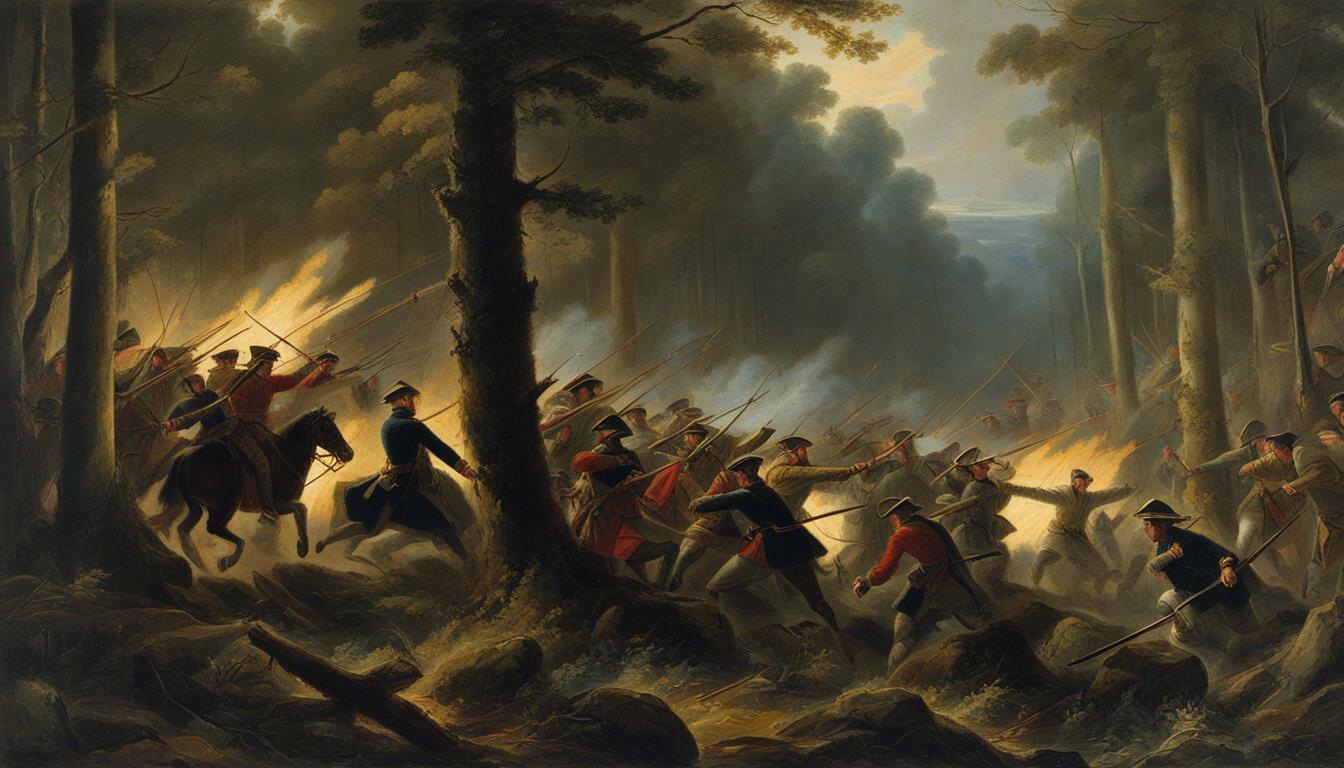The Ambush of Geary, also known as the Amwell Skirmish, was a pivotal moment during the American Revolutionary War. On December 14, 1776, the skirmish took place in Amwell Township, New Jersey, and forever changed the course of the war.
The ambush strategy employed by local militiamen led by Captain John Schenck resulted in the death of Cornet Francis Geary, leader of a company of dragoons. Geary’s body was hidden and buried in a shallow grave, preventing its recovery by British troops.
Key Takeaways:
- The Ambush of Geary was a significant event in the American Revolutionary War.
- It took place in Amwell Township, New Jersey, on December 14, 1776.
- Local militiamen led by Captain John Schenck ambushed and killed Cornet Francis Geary, leader of a company of dragoons.
- Geary’s body was hidden and buried, preventing its recovery by British troops.
- The ambush hindered British reconnaissance efforts and contributed to George Washington’s success in the Battle of Trenton.
Background of the Conflict
The Ambush of Geary was a direct result of the ongoing conflict between British forces and American militia during the American Revolutionary War. As tensions escalated and hostilities grew, both sides engaged in a series of skirmishes and attacks to gain strategic advantages. The Amwell Skirmish, where the Ambush of Geary took place, exemplified the determination of the local militiamen to resist British forces.
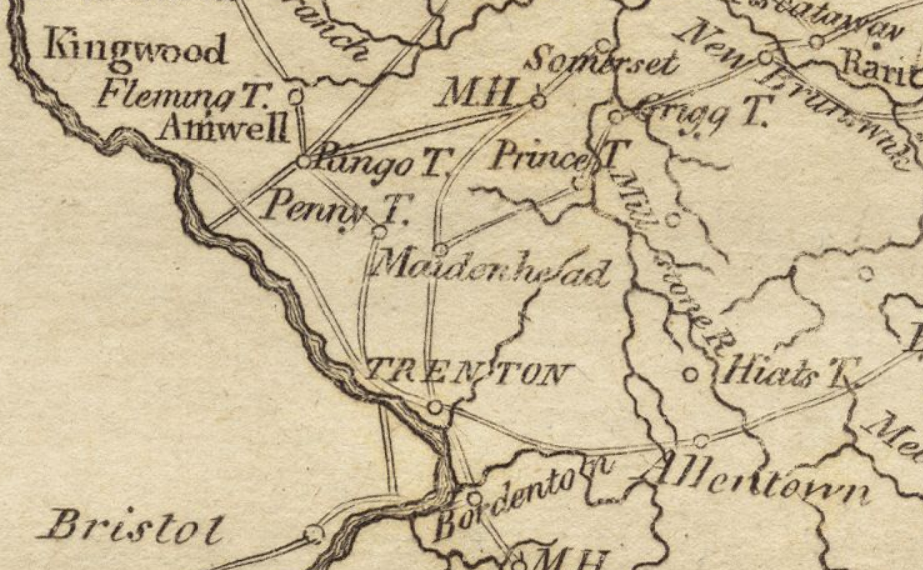
Amidst the larger military engagements, the conflict in Amwell Township intensified as the American revolutionaries sought to disrupt British plans and secure their own foothold in the region. The British forces, led by Cornet Francis Geary, faced increasing resistance from the local militia, led by Captain John Schenck. The clash of ideologies and the struggle for control over the area fueled the tensions that eventually led to the ambush.
The Amwell Skirmish, also known as the Ambush of Geary, occurred on December 14, 1776. The British dragoons, under the command of Geary, were unaware of the well-planned ambush by the local militiamen. As they advanced through Amwell Township, they were met with heavy resistance and suffered significant casualties. The ambush not only inflicted a blow to British forces but also boosted the morale of the American revolutionaries, encouraging them to continue their fight for independence.
To ensure the success of their ambush, the local militiamen hid Geary’s body and prevented its recovery by British troops. This act of defiance further emphasized their commitment to the cause and denied the enemy the opportunity to retrieve fallen comrades. The Ambush of Geary, in conjunction with other militia actions, hindered British reconnaissance efforts and played a crucial role in George Washington’s subsequent victory at the Battle of Trenton.
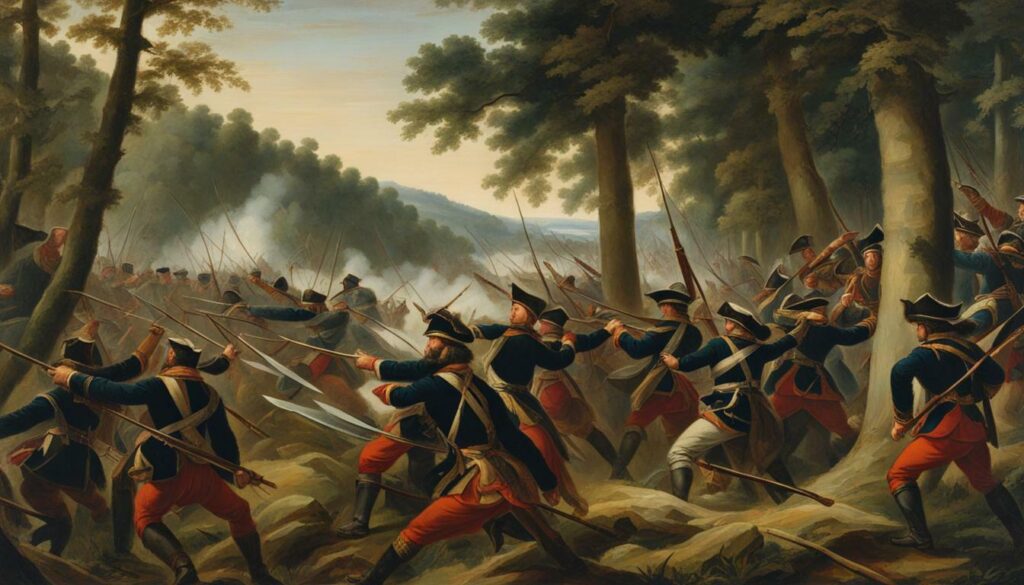
| Key Points | Details |
|---|---|
| Date | December 14, 1776 |
| Location | Amwell Township, New Jersey |
| Leaders | Cornet Francis Geary (British) and Captain John Schenck (American) |
| Outcome | Geary was killed, his body concealed, and the ambush hindered British reconnaissance efforts. |
Key Figures in the Ambush
The Ambush of Geary was orchestrated by Captain John Schenck and saw the unfortunate demise of Cornet Francis Geary, a leader of British dragoons. Captain John Schenck, a prominent figure in the local militiamen, played a pivotal role in organizing and executing the ambush. Known for his strong leadership skills and strategic thinking, Schenck led his troops with determination and precision.
Serving as the leader of a company of dragoons, Cornet Francis Geary represented the British forces in the Amwell Skirmish. Geary was responsible for reconnaissance and scouting along the Delaware River, tasked with gathering intelligence about American troop movements. Unfortunately for Geary, his mission was cut short by the successful ambush, resulting in his untimely death.
Other notable participants in the ambush included several local militiamen who fought alongside Captain Schenck. Though their names may have been lost to history, these brave individuals demonstrated their unwavering commitment to the cause of the American Revolution. Their actions not only showcased the strength of the local militia but also contributed to the overall success of George Washington’s campaign.
| Key Figures | Role |
|---|---|
| Captain John Schenck | Leader of the local militiamen |
| Cornet Francis Geary | Leader of the British dragoons |
| Local Militiamen | Contributed to the success of the ambush |
The courageous actions of Captain John Schenck, Cornet Francis Geary, and the local militiamen during the Ambush of Geary demonstrated the determination and bravery of the American forces. Their strategic thinking and successful execution of the ambush hindered British reconnaissance efforts and played a crucial role in George Washington’s victory at the Battle of Trenton.
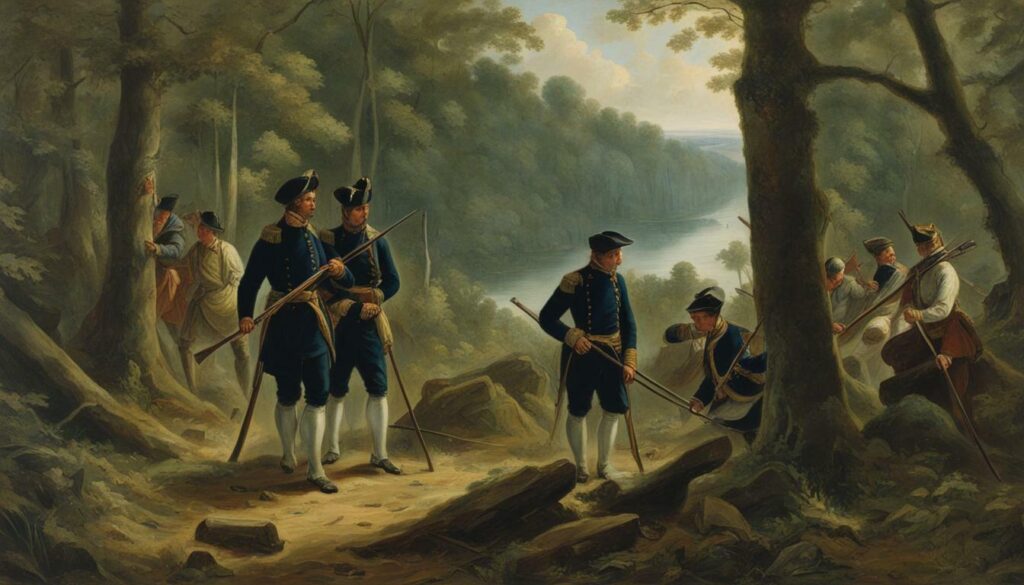
The Ambush of Geary unfolded through a well-planned surprise attack on Cornet Francis Geary and his dragoons, catching them off guard and changing the course of the Revolutionary War. The events leading up to the ambush were marked by the strategic brilliance of the local militiamen, who capitalized on their knowledge of the terrain and the element of surprise to execute a devastating blow against the British forces.
The militiamen, under the leadership of Captain John Schenck, meticulously planned the ambush, taking advantage of their familiarity with the Amwell Township area. They strategically positioned themselves, waiting for the opportune moment to strike. When Geary and his dragoons, unaware of the impending danger, entered the area, they were met with a sudden and fierce attack.
The surprise attack on Geary and his dragoons was a testament to the resourcefulness and determination of the American militia. Their ability to conceal their intentions and exploit the element of surprise allowed them to swiftly neutralize a significant threat and gain a crucial advantage in the conflict. This successful ambush would prove to have far-reaching implications for the outcome of the American Revolutionary War.
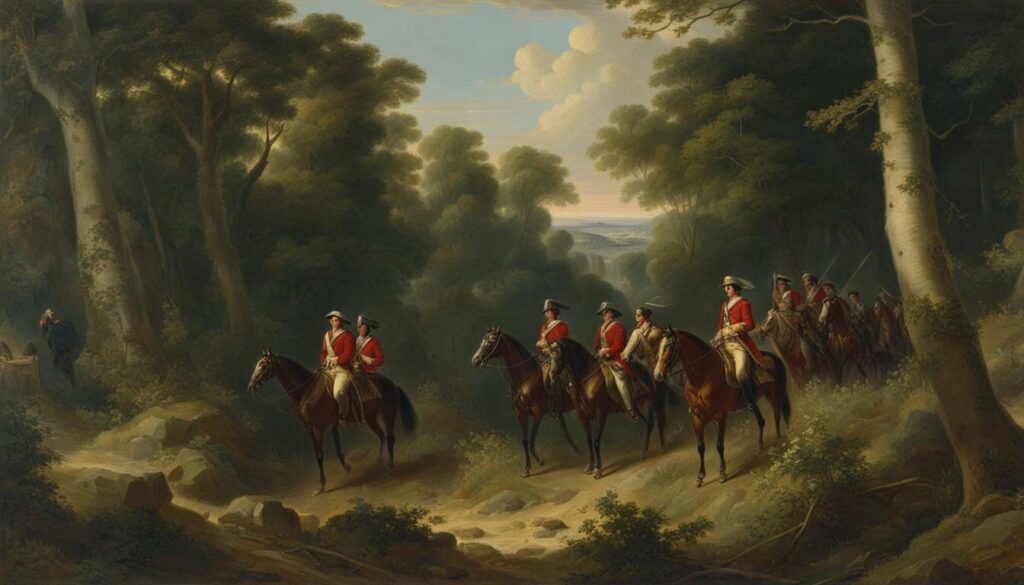
Striking a Blow
The ambush strategy employed by Captain Schenck and his militia forces caught Geary and his dragoons completely off guard. The suddenness and ferocity of the attack left them with little time to react or mount a defense. The militiamen, armed with local knowledge and a deep understanding of the terrain, effectively utilized the element of surprise to their advantage, dealing a significant blow to the British forces.
By eliminating Geary and concealing his body, the militia prevented the British from recovering key intelligence and disrupted their reconnaissance efforts in the region. This hindered the enemy forces and contributed to the overall success of George Washington’s campaign, particularly in the subsequent Battle of Trenton. The ambush of Geary stands as a remarkable example of the ingenuity and resourcefulness of American militia forces during the Revolutionary War.
| Militia Actions | Impact |
|---|---|
| Ambushing Geary | Neutralized a significant threat |
| Surprise attack on Geary | Disrupted British reconnaissance efforts |
| Contributed to George Washington’s success |
The Amwell Skirmish
The Amwell Skirmish witnessed fierce fighting between the local militiamen and Cornet Geary’s dragoons, resulting in a significant loss for the British forces. This intense battle unfolded on December 14, 1776, during the American Revolutionary War in Amwell Township, New Jersey. Led by Captain John Schenck, the militia launched a surprise attack on Geary’s dragoons, catching them off guard and quickly gaining the upper hand.
The militiamen employed tactics such as guerrilla warfare and hit-and-run attacks, constantly harassing Geary’s troops and preventing them from regrouping. This unconventional approach proved effective as they inflicted heavy casualties on the enemy, eventually forcing the British forces to retreat.
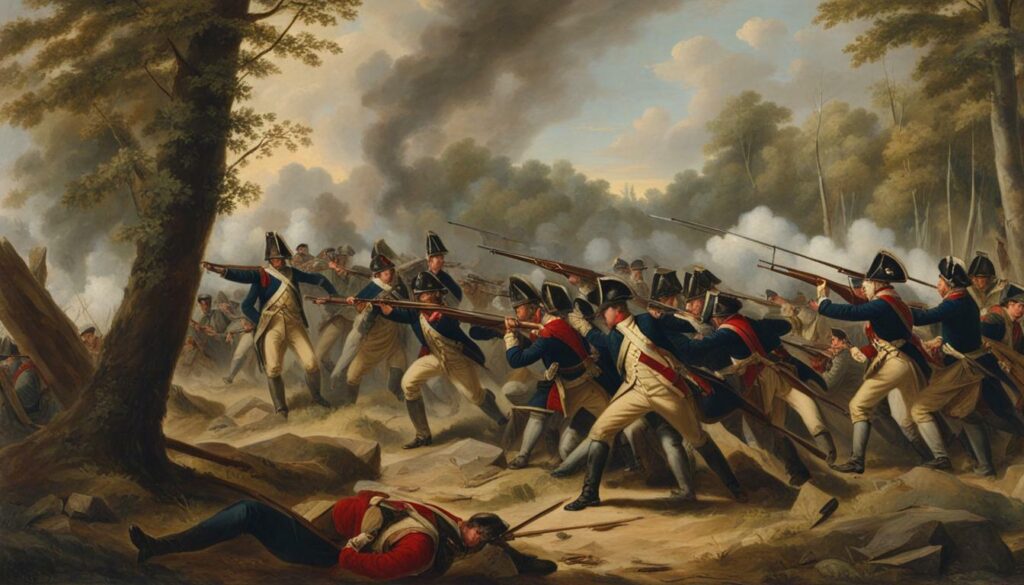
The Amwell Skirmish highlighted the resourcefulness and determination of the American militia, who were willing to engage in direct combat against well-trained British soldiers. This engagement served as a morale booster for the Continental Army, demonstrating that victory was possible against a formidable adversary.
For the British forces, the defeat at the Amwell Skirmish was a wake-up call. It exposed the vulnerability of their troops to surprise attacks and highlighted the importance of robust intelligence and reconnaissance. The loss of Cornet Geary, a respected leader within the British ranks, further compounded their defeat and led to a temporary disruption in their operations in the region.
In conclusion, the Amwell Skirmish was a pivotal moment in the American Revolutionary War. It showcased the effectiveness of guerrilla warfare tactics employed by the American militia, dealt a blow to British morale, and contributed to George Washington’s subsequent victories. This event is remembered as a symbol of American resilience and determination in the face of adversity, marking a significant milestone in the path towards independence.
Concealing Geary’s Body
Recognizing the importance of denying the British the recovery of Cornet Geary’s body, the local militiamen concealed it, disrupting the enemy’s plans and complicating their reconnaissance efforts. By hiding the fallen officer, the militia not only deprived the British of valuable intelligence but also sent a powerful message of defiance and determination.
The decision to keep Geary’s body hidden was a strategic move aimed at impeding the enemy’s ability to gather information about the local militia and their operations. It forced the British to divert resources and expend additional effort in searching for the missing Cornet, diverting their attention away from other crucial military objectives.
“The concealment of Geary’s body was a stroke of tactical brilliance that showcased the resourcefulness and resolve of the American militia.” – Captain John Schenck
The hidden body disrupted the British plans and complicated their reconnaissance efforts, making it more challenging for them to accurately assess the strength and movements of the local militia. This unexpected obstacle further weakened the British position and contributed to the success of George Washington’s subsequent military actions.
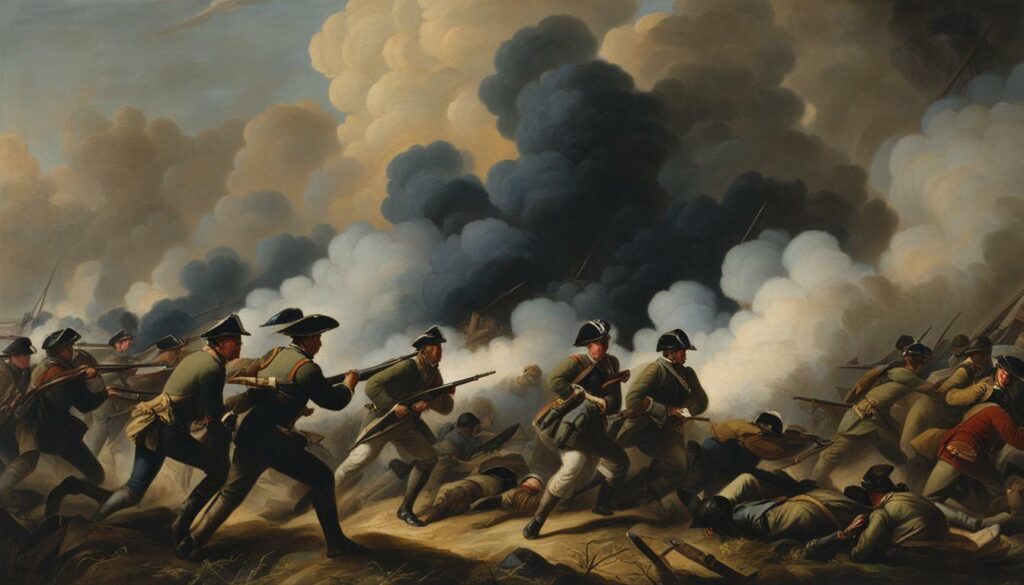
The concealment of Cornet Geary’s body had far-reaching implications for the American Revolutionary War. It sent a powerful message to the British forces, demonstrating the determination and resourcefulness of the American militia. This act of defiance bolstered the morale of the local fighters and showcased the commitment of the colonists to their cause.
Moreover, the disrupted reconnaissance efforts following the concealment hindered the British intelligence-gathering capabilities, providing a significant advantage to the American forces. The hidden body forced the British to reassess their strategies and devote resources to finding Geary, diverting them from other critical military operations. This disruption, combined with other militia actions, played a crucial role in George Washington’s successful crossing of the Delaware River and his victory in the consequential Battle of Trenton.
| No. | Implications |
|---|---|
| 1 | Disrupted British reconnaissance efforts |
| 2 | Forced diversion of enemy resources |
| 3 | Strengthened American militia’s morale |
| 4 | Contributed to the success of subsequent military actions |
Implications for George Washington
The Ambush of Geary, along with other militia actions, presented a significant challenge for the British forces and ultimately contributed to George Washington’s victory in the Battle of Trenton. This strategic ambush, which took place on December 14, 1776, in Amwell Township, New Jersey, hindered the British reconnaissance efforts and disrupted their plans. The actions of the local militiamen under the leadership of Captain John Schenck demonstrated the determination and resourcefulness of American forces.
By targeting and eliminating Cornet Francis Geary, leader of a company of dragoons, the American militia inflicted a blow on the British forces and weakened their position. This surprise attack not only deprived the British of an experienced leader but also sent a message that the American militia was a formidable adversary. The successful ambush boosted morale among Washington’s troops and paved the way for their subsequent triumph in the Battle of Trenton.
The Battle of Trenton, which took place on December 26, 1776, just twelve days after the Ambush of Geary, marked a turning point in the American Revolutionary War. Washington’s victory against the Hessian mercenaries stationed in Trenton reinvigorated the American cause and boosted recruitment efforts. The audacious tactics employed in the ambush and the subsequent battle demonstrated Washington’s strategic acumen and inspired confidence in the ability of American forces to resist the British.
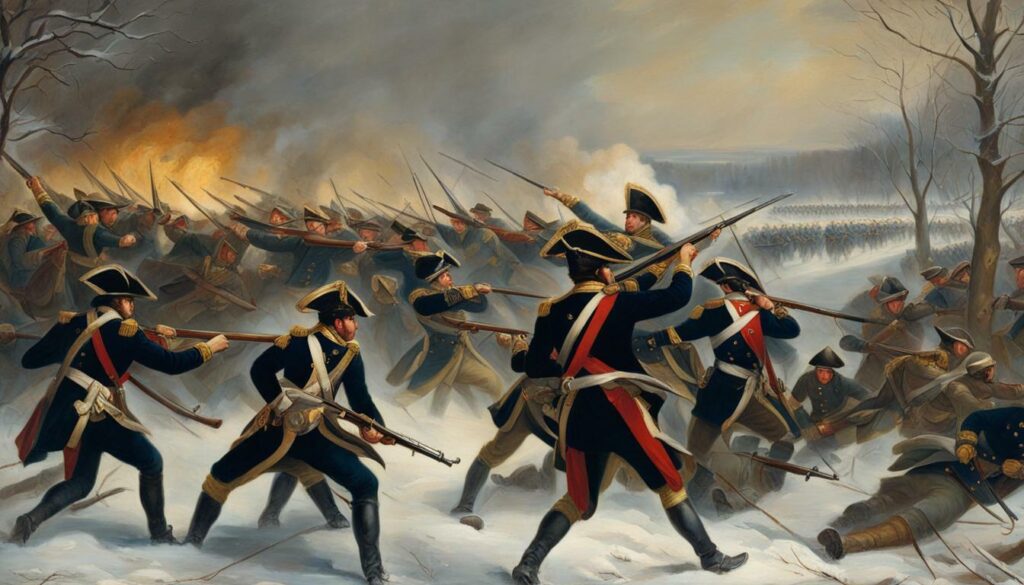
The successful Ambush of Geary not only hindered British reconnaissance efforts but also disrupted their plans and weakened their hold on the region. This, in turn, allowed Washington’s army to cross the Delaware River undetected and surprise the enemy at Trenton. The combination of the ambush and the subsequent victory in the Battle of Trenton proved to be a turning point in the Revolutionary War, boosting American morale and setting the stage for future successes.
Significance in Revolutionary War History
The Ambush of Geary stands as a testament to the bravery and resourcefulness of American militia forces during the Revolutionary War, playing a significant role in the eventual victory of the American colonies. This daring act of local militiamen, led by Captain John Schenck, showcased the determination and resilience of the American people in their fight for independence.
The Amwell Skirmish was a crucial turning point in the Revolutionary War, demonstrating the effectiveness of guerrilla tactics against British forces. It served as a powerful morale boost for the American troops and undermined the confidence of the British army.” – General George Washington
The ambush disrupted British reconnaissance efforts and hindered their ability to gather crucial intelligence on American troop movements. This strategic advantage contributed directly to George Washington’s successful crossing of the Delaware River and subsequent victory in the pivotal Battle of Trenton. By taking out Cornet Francis Geary, an influential leader of British dragoons, the militia effectively weakened British command and control.
The Ambush of Geary also demonstrated the importance of local knowledge and familiarity with the terrain in military engagements. The militiamen’s intimate understanding of the Amwell Township area allowed them to plan and execute the ambush with precision, catching the British troops off guard. This event highlighted the significant role that local communities played in the Revolutionary War and their ability to disrupt enemy operations.
The bravery and ingenuity displayed during the Ambush of Geary became a source of inspiration for American troops throughout the Revolutionary War. It served as a reminder that victory was possible, even against a formidable opponent. The legacy of this ambush continues to be celebrated and commemorated today, serving as a powerful symbol of American resilience and determination in the fight for freedom.
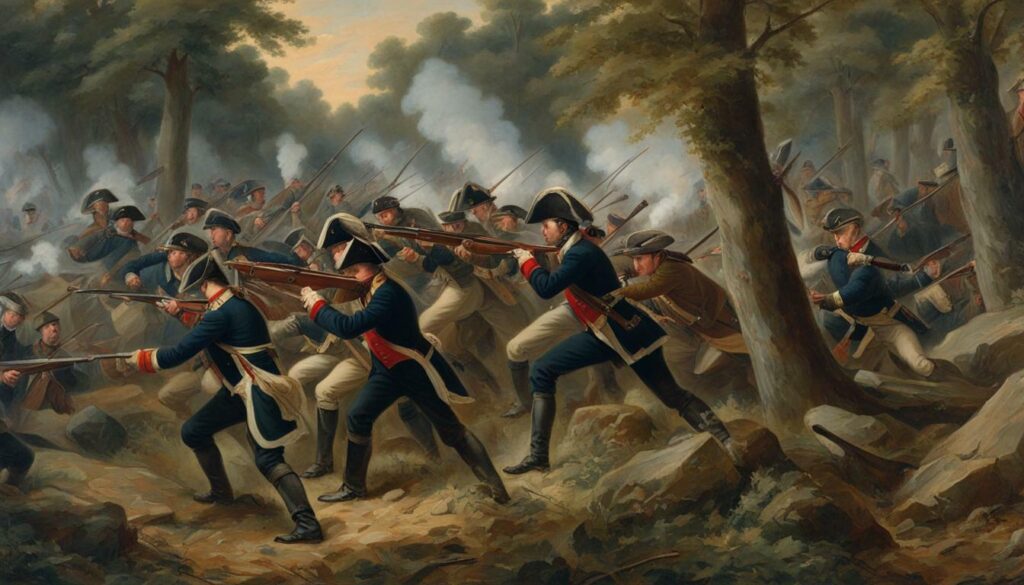
| Key Figures | Role |
|---|---|
| Cornet Francis Geary | Leader of British dragoons |
| Captain John Schenck | Commander of local militiamen |
Legacy of the Ambush of Geary
The Ambush of Geary continues to be remembered as a crucial moment in the American Revolutionary War, serving as a symbol of the resilience and determination of the American people in their fight for independence. This daring act by local militiamen in Amwell Township, New Jersey, showcased the effectiveness of guerrilla tactics against the superior British forces. The ambush, which resulted in the death of Cornet Francis Geary, struck a blow against the British military and hindered their reconnaissance efforts.
The Amwell Skirmish, as it came to be known, had significant implications for the success of George Washington’s campaign. By disrupting British operations and preventing the recovery of Geary’s body, the militia fighters not only undermined the morale of their enemies but also contributed to Washington’s victory in the subsequent Battle of Trenton. This decisive engagement breathed new life into the American cause and marked a turning point in the war.
The legacy of the Ambush of Geary endures in the collective memory of the American people, serving as a testament to the determination and perseverance of the revolutionaries. This event, along with other acts of resistance against British forces, galvanized the spirit of independence and bolstered the resolve to secure freedom from colonial rule. The Amwell Skirmish serves as a reminder of the sacrifices made by those who fought for liberty and continues to inspire generations to stand up for their beliefs.
Table: Key Figures in the Ambush
| Name | Role |
|---|---|
| Cornet Francis Geary | Leader of the dragoons |
| Captain John Schenck | Militia commander |
| Other notable participants | Militiamen and dragoons |
“The Amwell Skirmish serves as a reminder of the sacrifices made by those who fought for liberty and continues to inspire generations to stand up for their beliefs.”
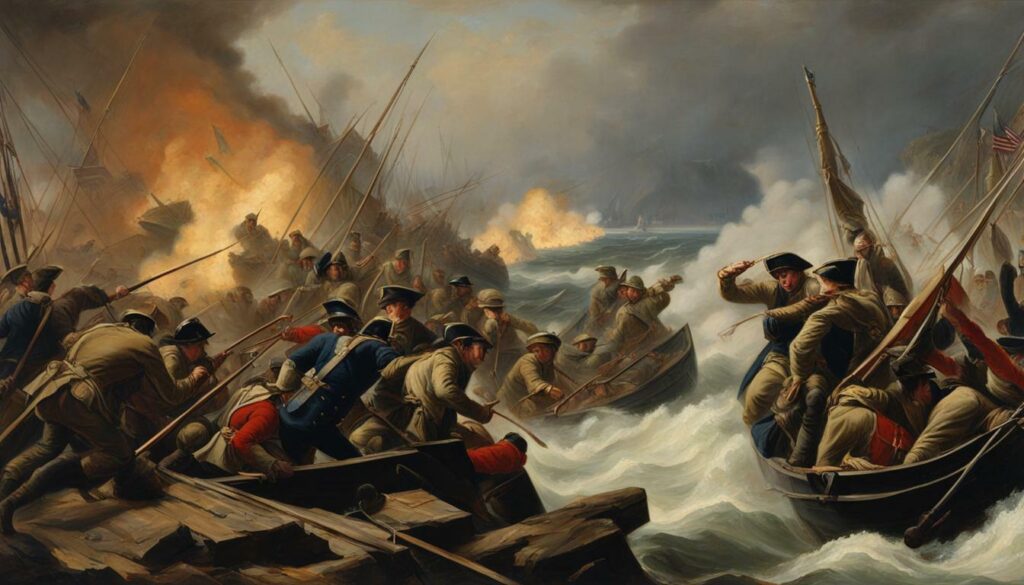
Historical Significance of Amwell Township
Amwell Township holds a special place in Revolutionary War history due to its association with the Ambush of Geary, and its historical significance is still evident today. The township, located in New Jersey, was the site of a pivotal skirmish that took place on December 14, 1776. This skirmish, also known as the Amwell Skirmish, saw local militiamen under the leadership of Captain John Schenck successfully ambush and kill Cornet Francis Geary, who commanded a company of dragoons.
The Ambush of Geary highlighted the determination and resourcefulness of American militia forces during the Revolutionary War. The militiamen employed guerrilla tactics and utilized the element of surprise to their advantage, resulting in the successful elimination of a key British officer. This strategic victory not only boosted morale among the American forces but also hindered British reconnaissance efforts, providing a crucial advantage to General George Washington and his troops.
In present times, Amwell Township proudly commemorates its role in the Ambush of Geary. The township’s historical significance is honored through the preservation of numerous landmarks and monuments that pay tribute to this important event. These sites serve as a reminder of the valor and sacrifice displayed by the local militiamen who fought for American independence.
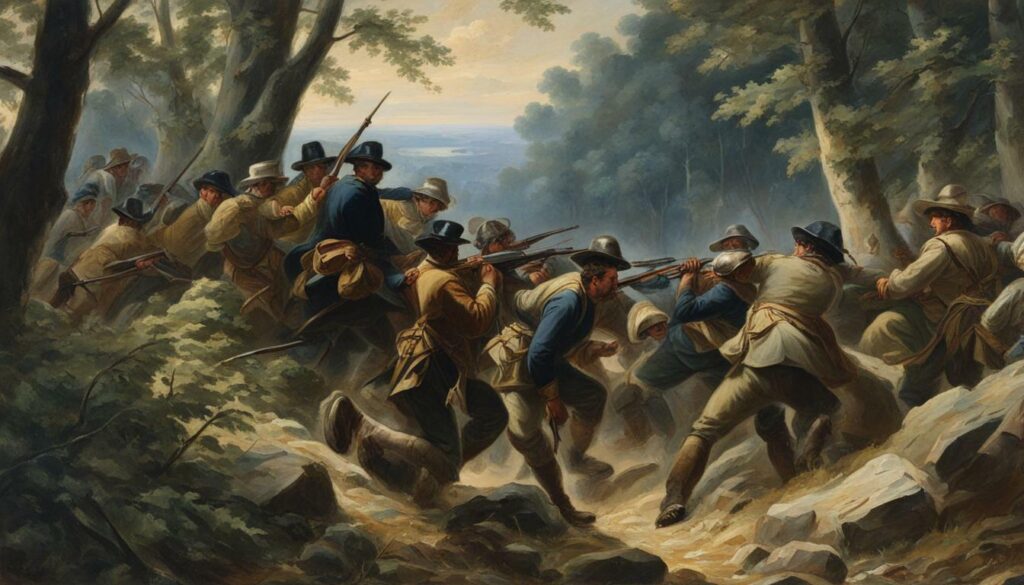
| Landmark/Monument | Description |
|---|---|
| Geary Memorial Park | A public park dedicated to the memory of Cornet Francis Geary and the militiamen who participated in the ambush. The park features a monument with inscriptions detailing the events of the Amwell Skirmish. |
| Schenck House | The historic Schenck House, once the residence of Captain John Schenck, has been preserved and transformed into a museum. Visitors can explore the house and learn about the life and contributions of Captain Schenck and his role in the Ambush of Geary. |
| Geary Gravesite | A secluded gravesite where Cornet Francis Geary was buried following the ambush. The site is marked by a simple headstone and serves as a solemn reminder of the sacrifices made during the Revolutionary War. |
The Ambush of Geary and its connection to Amwell Township continue to captivate historians and visitors alike. This significant event serves as a testament to the bravery and determination of the American militia forces, leaving a lasting legacy in Revolutionary War history.
Conclusion
The Ambush of Geary, a pivotal historical event during the American Revolutionary War, demonstrated the effectiveness of militia actions and significantly contributed to American victories in the war. Taking place on December 14, 1776, in Amwell Township, New Jersey, the ambush saw Cornet Francis Geary, leader of a company of dragoons, fall victim to local militiamen led by Captain John Schenck. Geary’s body was skillfully hidden and buried, preventing its recovery by British troops.
This ambush, along with other militia actions, played a crucial role in hindering British reconnaissance efforts and ultimately aiding George Washington’s campaign. By disrupting the enemy’s ability to gather intelligence, the militia contributed to Washington’s successful crossing of the Delaware River and subsequent triumph in the Battle of Trenton.
The Amwell Skirmish showcased the determination and resilience of American militia forces, highlighting their ability to execute strategic surprise attacks on the British. This event became a symbol of American resistance and symbolized the spirit of defiance that characterized the Revolutionary War. Its significance in Revolutionary War history cannot be overstated.
Today, the Ambush of Geary is remembered and commemorated as an important moment in American history. The bravery and resourcefulness displayed during this skirmish continue to inspire and serve as a reminder of the sacrifices made during the fight for independence. The historical significance of Amwell Township as the site of this ambush is also recognized, with efforts made to preserve and commemorate its role in the Revolutionary War.
FAQ
Q: What was the Ambush of Geary?
A: The Ambush of Geary, also known as the Amwell Skirmish, was a skirmish that took place during the American Revolutionary War on December 14, 1776, in Amwell Township, New Jersey. Cornet Francis Geary, leader of a company of dragoons, was ambushed and killed by local militiamen led by Captain John Schenck.
Q: Where was Geary’s body buried?
A: Geary’s body was hidden and later buried in a shallow grave, preventing its recovery by British troops.
Q: How did the ambush hinder British reconnaissance efforts?
A: The ambush, along with other militia actions, hindered British reconnaissance efforts and contributed to George Washington’s success in crossing the Delaware River and winning the Battle of Trenton.

